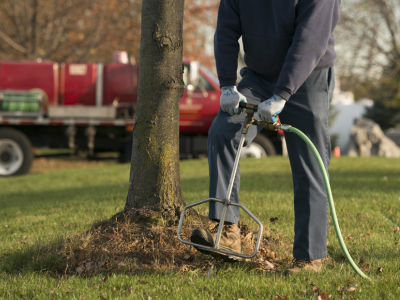Tree Fertilization

Fertilizing your tree will provide a big impact to the health of your tree in both the short term and long term. More than pruning, more than any other tree care service. There is a lot to know about tree fertilizers. This article is meant to be an introduction to tree fertilizer. I highly recommend you read my three other articles in this series: When to Fertilize trees, How to Apply Fertilizers to Trees, and What Products to Use for Fertilizing Trees.
You can compare tree fertilization to your own health care. Without it, you are not going to wither and die tomorrow. But, with proper health care (fertilization regimen) your tree will have a healthier, more full canopy of foliage. And, if a good fertilization regimen is follow for a few consecutive years, sick trees can return to a healthy state and regain extended life expectancy.
One of the biggest misconceptions I find people to have is a perception that tree fertilization mostly make a tree grow faster. I can see where someone would come to this conclusion. Most of us get our experience in fertilizers from grass fertilizing. Grass fertilizers do result in faster growing grass. Trees are different that grass. Grass is in a constant state of growth and trees only grow a few times a year; we call these growth increments flushes. The ultimate goal with trees is to time the right treatments so that roots are stimulated to grow faster, but foliage is stimulated to develop better (not grow faster).
Timing is critical. Here are the basics you need to know about timing: most root growth takes place in the fall; most foliage growth takes place in early spring; there is not much growth in the middle of the “growing season.” With this knowledge you should be able to deduct that fertilizing in the summer would be a waste of time. During the spring you should use unconventional treatments to stimulate healthy development not conventional fertilizers that would stimulate growth. Your conventional fertilizer should be applied in the fall when roots are doing most of their growing.
Here are some common comments I hear about tree fertilizing:
Q: These trees were growing here long before I was here. They didn’t need fertilizer before, why now?
A: Ok, true. But, before you were here there was a natural balance of nutrient recycling. Now, the soil’s litter layer is gone and replace with grass.
Q: Fertilizing is just going to make it grow faster, then I’ll have to prune it more.
A: We just discussed that a good fertilizer regimen doesn’t stimulate growth. Quite the opposite, healthier trees will produce fewer dead limbs over time, therefore, reducing pruning needs.
Q: I don’t like putting chemicals in my yard.
A: You shouldn’t. But, what are you considering as chemical? Fertilizers are less harsh that virtually any cleaning supply you use and you actually get that stuff all over your hands and up your nose. And, if you get your timing right you can reduce your application rate dramatically. We target about ¼ lb nitrogen per medium sized tree per year. That’s 12 times less that what is recommended for 1000 sq. ft. of lawn. Every other product we use is not chemical at all (see my article on what products to use for trees).
One last topic I want to discuss before leaving is soil restructuring. Many of the trees if our urban environment get left with small little islands of soil to grow from.